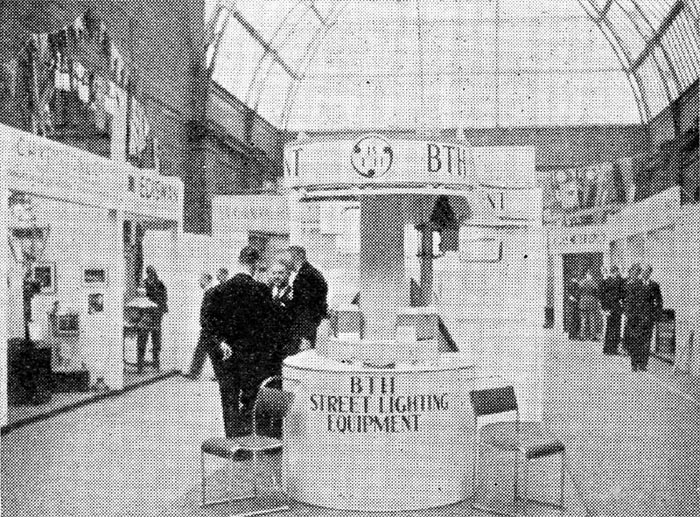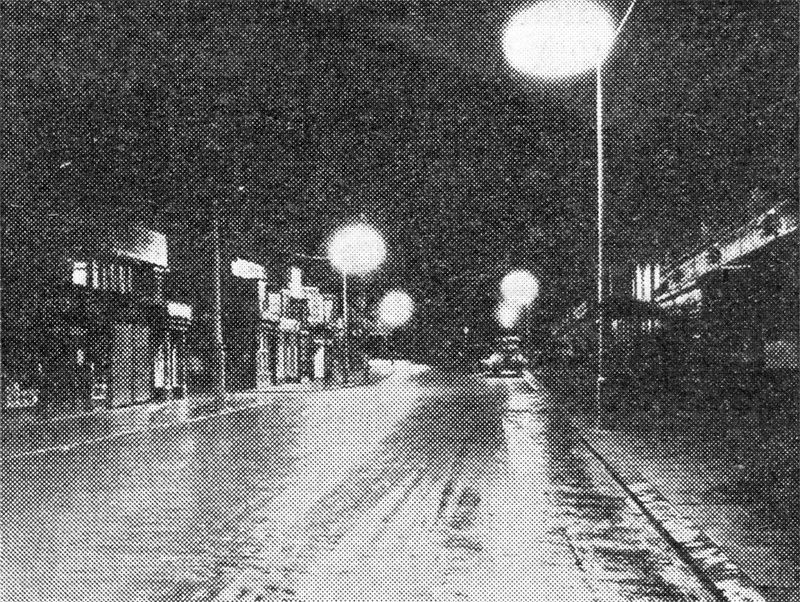|
bth

|
British Thomson-Houston Company, Ltd.
Crown House,
Aldwych,
London WC2
England
|

BTH's booth at the 1936 APLE Conference.
Exhibits included Mercra Lamps (150W, 250W and 400W) and Lighting Equipment for street lighting and
flood lighting. The new Dilen and Diref lanterns were shown. - Public Lighting #3, 1936
The firm are exhibiting several installations at the APLE's Folkestone Conference of 1937. The layouts
use "BTH Planned Street Lighting" principles, which ensures that the very best use is made of each
individual lantern. Use of these principles allows a spacing of 150 ft., which is the maximum
recommended by the interim report of the Ministry of Transport Committee on Street Lighting.
The firm notes how cream coloured walls along some of the routes enhance the lighting. The
County Junior is one of the lanterns being exhibited. - APLE Conference Programme Folkestone 1937
The newly designed Mercra H lantern takes centre stage, along with a representative range
of Mercra (80W, 125W, 250W and 400W) and Sodra Lamps, together with BTH Auxiliary Equipment for
Street Lighting. - APLE Conference Programme Folkestone 1938
They have issued a booklet, Planned Street Lighting, of over seventy pages,
fully illustrated which describes the various types of lamps, lanterns and accessory equipment manufactured by
the company. The booklet is much more than a mere catalogue or list of BTH street lighting
products; it is a guide to correct methods, as approved by the latest practice. Prolonged laboratory work
has enabled the company's engineers to establish basic principles and to ascertain the most suitable sources of
light and the most effective systems of light distribution for general requirements. Then comes the application of the knowledge,
thus gained by practical tests on roads and streets. The results of this wide experience is embodied admirably and lucidly in
the new booklet. Details are given of the Mercra range of electric discharge lamps,
and of several lanterns designed for different classes of road. The Sodra electric discharge lamps
are also described; and the County Junior lantern, which is low priced and suitable for either
Mercra or Mazda lamp, is exceptionally effective for side roads. A description is
included of BTH photoelectric relays and their action in street lighting control; of the foot-candle
meter for testing; and finally a couple of pages are given to illuminated traffic signs and guard posts; all models
conforming to MOT requirements. In brief, Planned Street Lighting covers all the principle needs
of authorities who may wish for information on the subject. - Public Lighting #12, January 1939
The Mercra "H" has been a huge success and the firm have designed a sodium counterpart,
the Sodra "H" for the whole range of sodium lamps. The Sodra "H" also
includes many engineering improvements in design, most being related to its side entry
design. (The Dilen lantern has also been redesigned for side-entry to take
advantage of these). The Sodra "H" is being exhibited. - APLE Conference Programme Glasgow 1939
Pioneers in modern electric street lighting. Before the war hada wide range of lamps and
lanterns on the market. Many will be made available after the war. - Public Lighting #44, 1944
The company describe the pre-war scene, with special reference to the Mercra "H"
and Dilen lanterns. In some respects, they seem to feel that
street lighting has reached a natural goal: "The methods employed,
therefore, in the lighting of streets, especially main roads, are to a large
extent stabilized, and it is difficutl to visualise any extensive changes
unless a considerably greater amount of money per mile is going to be
available in the future." The County Junior and
County Cadet lanterns are the standard products for
side sreets. In reality, the firm are still selling 1939 stock, and have
justified this by claiming that there has been no progress made in the war and immedaite
post-war years. - APLE Conference Programme Glasgow 1945
In the last year, the volume of traffic on the roads has steadily been increasing and
has bought an appalling increase in the number of road accidents. The provision of adequate
street lighting will not only do much to reduce accidents, but will also simplify the
battle against crime. The past year has seen a resumption of intensive research work which
has resulted in striking improvements in the science of street lighting. There are two
thoughts constantly in mind when designing street lighting: the need to improve the lighting
of our streets and the need to conserve fuel in the form of electric current. It is not
possible to produce a single lantern which will do service in all circumstances because roads
and streets vary in their indiviudal requirements. It is possible to design a range of
lanterns to meet the demands of main streets and side streets; of arterial roads and
secondary roads. This has been done: there is a Mazdalux lantern to meet every
requirement.
Illuminated panels show how the careful siting of a lantern can make striking improvements to
the lighting of public highways. Typical cross roads, roundabouts, T-junctions, bends and single and
dual carriageways are depicted to demonstrate how the maximum amount of light can be
directed where it is most needed. The Mazdalux lanterns displayed are typical of the
very wide range designed by the company to meet all requirements.
Demonstrate prototype fluorescent lantern along Old Bond Street in London for the conference. - APLE Conference Programme London 1946

Installation of BTH Fluorescent lanterns along Neville Street for the APLE's 1947 Conference.
After the experimental installation along Old Bond Street, constant research, coupled with experience of many
installations in other cities and towns, has led to the development of an improved lantern which is in
full production. One is on view in Southport. The installation is mounted
on specially designed concrete columns by Concrete Utilities. The mounting height is 25-ft. as recommeneded for
Group A by the M.O.T. Report. Fluorescent street lighting has more than fulfilled the promise of the first experimental
installations and has now been accepted as providing better visibility than any system hitherto employed. Fluorescent
street lighting has other distinct advantages: Gives a light which closely matches the light of day; the comparatively
large light source gives a very full coverage of the road and a broad even light distribution which embraces kerbs,
pathways and buildings; the lamps have a long life; and they give about two and a half times as much light as
incandescent lamps. - APLE Conference Programme Southport 1947
The firm was consolidated into AEI Lamps And Lighting in 1956. The old manufacturing name of BTH
was dropped and the tradename of Mazda was continued by AEI.
References:
The Illuminating Engineer 1928
APLE Conference Programme Folkestone 1937
APLE Conference Programme Bournemouth 1938
APLE Conference Programme Glasgow 1939
APLE Conference Programme Glasgow 1945
APLE Conference Programme London 1946
APLE Conference Programme Southport 1947
- External Links:
- Grace's Guide
|



